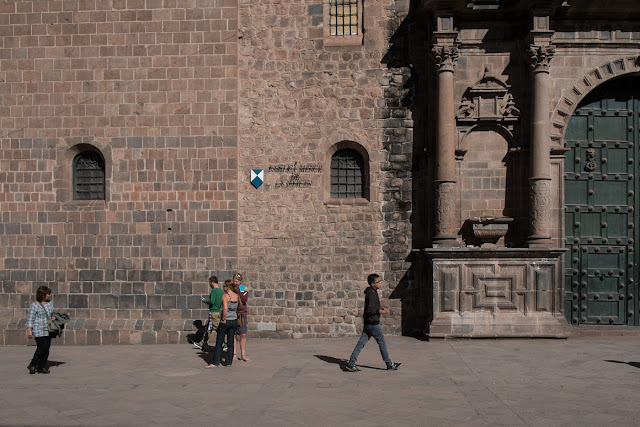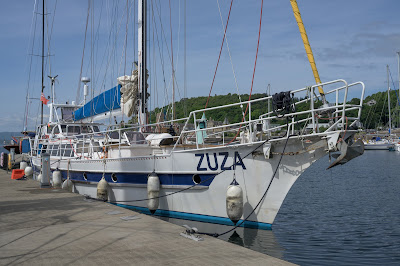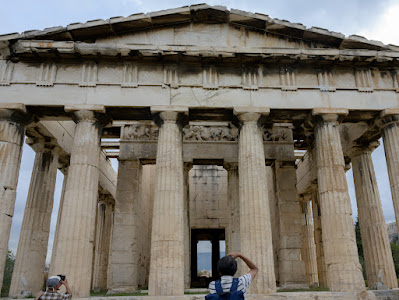The day after the Inca Trail we decided to take it easy. So we had a walk around Cusco and visited the Inca Museum and the Cathedral. Naomi was still not 100% and Mairi slipped on the steps of the Cathedral and acquired the most enormous bruise on her bottom!
 |
| In Cusco - outside the Merced |
 |
| The Cathedral Steps |
We were not greatly impressed with the Inca Museum. It seemed a little tired and sometimes they had 'English Subtitles' but mainly not. I would definitely learn Spanish before making another trip to South America. Fortunately Naomi could get by but English is not widely spoken.
In the courtyard of the museum there were some people weaving by traditional methods.
Having decided earlier to leave Cusco, that evening we caught the night bus to Araquipa where we arrived around 7.00 in the morning
Araquipa is a very fine colonial city with a big central square, it is a World Heritage Site. It lies due south of Cusco, still in the Andes and is backed by the volcano El Misti which makes it very picturesque.
We had a rest when we arrived and then walked into the main square - the Plaza de Armas and booked a trip out to Colca Canyon for the next day. The main square had the normal complement of pigeons being fed. We bought some lunch from a nearby supermarket and sat on a bench in the heat watching the world go by.
 |
| Lady selling apples |
 |
| The Cathedral |
 |
| The Cathedral with the volcano El Misti in the background |
 |
| Main Square - Plaza de Armas |
 |
| Pigeon of Araqipa |
After lunch we visited the Museo Sanctuarios Andinos, a museum famous for containing the body of Juanita, the little girl who had been found frozen at the top of the Ampato Volcano, not far from Araquipa.
This was a really excellent museum and we really enjoyed our tour, which was guided. We did not actually see Juanita as she was 'resting' but we did see another girl Sarita who had been found on a neighbouring mountain.
When we arrived we first saw a video of how Juanita had been found in 1995 by the archaeologists Johan Reinhard and Jose Chavez along with the climber Miguel Zarate on the Ampato volcano. There had been an eruption of the neighbouring volcano Sabancaya and this had caused the ice cap on Ampato to melt. Juanita who had been frozen in the ice for 500 years was found to have tumbled a little way over the rim of the volcano at 6380m. As well as Juanita a number of her grave goods are on display as well as the textiles found on her body, her feathered headdress and an elaborately woven shawl and skirt decorated with gold jewellery. There are now several frozen children found in similar places dating from Inca times in this museum.
Juanita's story is that she was probably from a royal family in Cusco and had been raised with a small number of other children specifically to be used as a human sacrifice. She would have been chosen for her beauty and she would have thought that her life was dedicated to the gods, and that she would become divine after her death. It may have been the eruption of Sabancaya in the 15th century or it may have been as a result of a severe drought, but occasionally the Incas felt that it needed extreme measures to appease the gods. Juanita walked from Cusco along with priests all the way to the Ampato Volcano which must have taken days. She had several sets of shoes with her so she was prepared for a long trip. She had eaten the day before she arrived at the top of the mountain. There it is thought she was drugged and given chicha - alcohol to render her nearly unconscious. She was then killed by the priests using a heavy blow to her forehead. The priests moved her body in to a fetal position and wrapped in in cloth. They surrounded the body with things she would need for the afterlife and covered it with carved rocks. The body then froze, so she is not a conventional mummy, all her internal organs are intact and she has been studied to see if she suffered from any disease.
 |
| The exterior of the Museo Santuarios Andinos |
After the museum we wandered round the city looking at the exterior of a number of churches. The doorways of the Iglesia de la Compania were decorated in relief stone with a weird mixture of Catholic and native decoraton.
 |
| Igelsia de la Compania - side door |
 |
| Iglesia la Compania - front door |
 |
| The Cathedral |
After this we visited Araquipa's second most famous attraction - the Monasterio de Santa Catalina. This is situated behind a severe stone facade, but is a complete labyrinth of streets inside. It is still a fully functioning convent but the nuns (around 30 of them) are now in new accommodation which is locked away from prying eyes. It is the old buildings that you are allowed to wander round - and they are a real treat. The nuns occupied them from the late 16th century till 1970 and at one time the buildings contained around 200 nuns and 300 servants.The buildings are decorated in wonderful colours, earth pink and ochre and zingy blues. With the deep blue sky above and the flowers it all looks magnificent. The light also had a wonderful glowing quality. My camera battery ran out and I did not have a spare charged one which really annoyed me - rooky error.
Here are a few of the ones I did get.
 |
| Tourist in the convent - in the pink |
 |
| Tourists in the convent |
As if we hadn't had enough of churches, as it grew dark we visited the Cathedral.
The interior of the Cathedral was not too over ornate but did contain the framed montages of dressed dolls to portray the holy family. This seems customary in South America.
Before getting to bed in preparation for yet another early start we had a quick turn round the square as the street lights were coming on.
 |
| Iglesia y Convento de San Francisco |










































Comments
Post a Comment